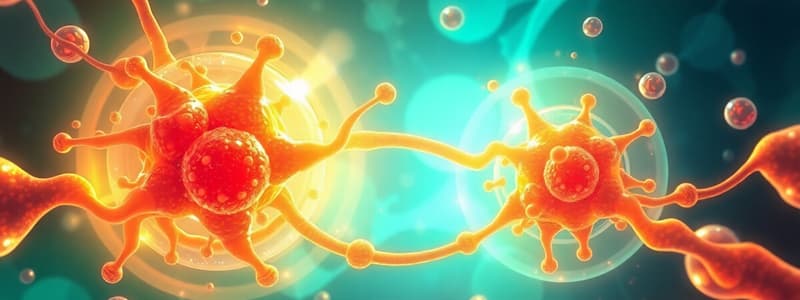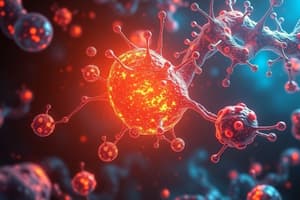Podcast
Questions and Answers
Which of the following drug is eliminated in alkaline urine?
Which of the following drug is eliminated in alkaline urine?
- Paracetamol
- Diclofenac
- Amphetamine
- Sulfonamide (correct)
What phenomenon can occur in the case of using a combination of drugs?
What phenomenon can occur in the case of using a combination of drugs?
- Synergism (correct)
- Tachyphylaxis
- Accumulation
- Tolerance
Which receptor could be activated by noradrenaline?
Which receptor could be activated by noradrenaline?
- Alfa receptor (correct)
- Beta receptor
- Both alfa and beta receptors (correct)
- Dopaminergic receptors
Which of the following statements is correct about Isoproterenol?
Which of the following statements is correct about Isoproterenol?
Which of the following drug is eliminated in acidic urine?
Which of the following drug is eliminated in acidic urine?
Which of the following is a local hemostatic, Nasal decongestant direct-acting catecholamine?
Which of the following is a local hemostatic, Nasal decongestant direct-acting catecholamine?
What does the term "bioavailability" mean?
What does the term "bioavailability" mean?
What type of drug-drug interaction relates to absorption, biotransformation, distribution, and excretion processes?
What type of drug-drug interaction relates to absorption, biotransformation, distribution, and excretion processes?
Which of the following route of drug administration is preferred for administering a drug directly into the spinal cord?
Which of the following route of drug administration is preferred for administering a drug directly into the spinal cord?
What type of drug-drug interaction results from interaction at the receptor, cell, enzyme, or organ level?
What type of drug-drug interaction results from interaction at the receptor, cell, enzyme, or organ level?
Which of the following could better define "Conjugation"?
Which of the following could better define "Conjugation"?
Which of the following could define the drug's half-life (t 1/2)?
Which of the following could define the drug's half-life (t 1/2)?
Which of the following best refers to the bioavailability of a drug?
Which of the following best refers to the bioavailability of a drug?
Which of the following statement could define an agonist?
Which of the following statement could define an agonist?
Which drug activates Dopaminergic (D1 and D2) and adrenergic (alfa and beta) receptors?
Which drug activates Dopaminergic (D1 and D2) and adrenergic (alfa and beta) receptors?
Which of the following could refer to the term "chemical antagonism"?
Which of the following could refer to the term "chemical antagonism"?
Which of the following is more likely to be used as a nasal decongestant?
Which of the following is more likely to be used as a nasal decongestant?
Which of the following statements could define "Pharmacodynamics"?
Which of the following statements could define "Pharmacodynamics"?
Which of the following is noncatecholamine dual-acting adrenergic drugs which induce tachyphylaxis?
Which of the following is noncatecholamine dual-acting adrenergic drugs which induce tachyphylaxis?
What are the reasons for determining bioavailability?
What are the reasons for determining bioavailability?
Which of the following acts by enhancing the release of noradrenaline?
Which of the following acts by enhancing the release of noradrenaline?
Which type of drugs could be rapidly excreted by the alkalinization of urine?
Which type of drugs could be rapidly excreted by the alkalinization of urine?
Which effect may lead to toxic reactions when a drug is taken continuously or repeatedly?
Which effect may lead to toxic reactions when a drug is taken continuously or repeatedly?
Which among the given drugs is metabolized by MAO and COMT?
Which among the given drugs is metabolized by MAO and COMT?
Which of the following drugs is used for the prolongation of action of local anesthetics?
Which of the following drugs is used for the prolongation of action of local anesthetics?
Which of the following results from the drug biotransformation?
Which of the following results from the drug biotransformation?
Which type of drug interaction will occur If two drugs with the same effect, taken together, produce an effect equal in magnitude to the sum of the effects of the medications given individually?
Which type of drug interaction will occur If two drugs with the same effect, taken together, produce an effect equal in magnitude to the sum of the effects of the medications given individually?
Which of the following is an enzyme inducer?
Which of the following is an enzyme inducer?
Which of the following agents is a less lipophilic, more potent histamine receptor subtype-1 blocker with no central action and no atropine-like activity?
Which of the following agents is a less lipophilic, more potent histamine receptor subtype-1 blocker with no central action and no atropine-like activity?
Which of the following agents acts as an ecbolic drug used to induce parturition or abortion and control postpartum hemorrhage?
Which of the following agents acts as an ecbolic drug used to induce parturition or abortion and control postpartum hemorrhage?
Which of the following could treat both atropine and curare toxicity?
Which of the following could treat both atropine and curare toxicity?
Which of the following agents is of insignificant value in for treatment of peptic ulcer?
Which of the following agents is of insignificant value in for treatment of peptic ulcer?
Which of the following analgesic agents is safe to be used during pregnancy?
Which of the following analgesic agents is safe to be used during pregnancy?
Which of the following agents is a 5-HT agonist with antianxiety activities?
Which of the following agents is a 5-HT agonist with antianxiety activities?
Which of the following drugs is recommended for the treatment of carcinoid tumor in a 72-old lady and acts by blocking 5-HT receptors?
Which of the following drugs is recommended for the treatment of carcinoid tumor in a 72-old lady and acts by blocking 5-HT receptors?
Which of the following antispasmodic agents with muscarinic-blocking activities?
Which of the following antispasmodic agents with muscarinic-blocking activities?
Which of the following agents is considered physiological antagonist histamine?
Which of the following agents is considered physiological antagonist histamine?
Which of the following drugs is considered a parasympatholytic agent and could be used for examining the eye fundus due to its mydriatic effects?
Which of the following drugs is considered a parasympatholytic agent and could be used for examining the eye fundus due to its mydriatic effects?
Flashcards
Drug Elimination in Alkaline Urine
Drug Elimination in Alkaline Urine
The process by which a drug is removed from the body through urine that is less acidic than normal.
Enzyme Inhibitor
Enzyme Inhibitor
A substance that slows down or prevents the activity of an enzyme.
Drug-Drug Interaction: Synergism
Drug-Drug Interaction: Synergism
When two drugs combined produce a greater effect than the sum of their individual effects.
Noradrenaline Receptor
Noradrenaline Receptor
Signup and view all the flashcards
Isoproterenol: Beta-Adrenergic Agonist
Isoproterenol: Beta-Adrenergic Agonist
Signup and view all the flashcards
Drug Elimination in Acidic Urine
Drug Elimination in Acidic Urine
Signup and view all the flashcards
Adrenaline: Local Hemostatic, Nasal Decongestant
Adrenaline: Local Hemostatic, Nasal Decongestant
Signup and view all the flashcards
Bioavailability: Reaching Systemic Circulation
Bioavailability: Reaching Systemic Circulation
Signup and view all the flashcards
Drug-Drug Interaction: Pharmacokinetic Interaction
Drug-Drug Interaction: Pharmacokinetic Interaction
Signup and view all the flashcards
Intra-thecal Administration
Intra-thecal Administration
Signup and view all the flashcards
Drug-Drug Interaction: Pharmacodynamic Interaction
Drug-Drug Interaction: Pharmacodynamic Interaction
Signup and view all the flashcards
Conjugation: Drug Metabolism
Conjugation: Drug Metabolism
Signup and view all the flashcards
Drug Half-Life (t ½): Time for Elimination
Drug Half-Life (t ½): Time for Elimination
Signup and view all the flashcards
Bioavailability: Percentage Reaching Circulation
Bioavailability: Percentage Reaching Circulation
Signup and view all the flashcards
Drug Agonist: Receptor Activation
Drug Agonist: Receptor Activation
Signup and view all the flashcards
Dopamine: Multi-receptor Activator
Dopamine: Multi-receptor Activator
Signup and view all the flashcards
Chemical Antagonism: Inactive Compound Formation
Chemical Antagonism: Inactive Compound Formation
Signup and view all the flashcards
Nasal Decongestant: Adrenaline
Nasal Decongestant: Adrenaline
Signup and view all the flashcards
Pharmacodynamics: Drug's Effect on the Body
Pharmacodynamics: Drug's Effect on the Body
Signup and view all the flashcards
Ephedrine: Dual-Acting, Tachyphylaxis Drug
Ephedrine: Dual-Acting, Tachyphylaxis Drug
Signup and view all the flashcards
Bioavailability: Absorption and First-Pass Effect
Bioavailability: Absorption and First-Pass Effect
Signup and view all the flashcards
Cocaine: Noradrenaline Release Enhancer
Cocaine: Noradrenaline Release Enhancer
Signup and view all the flashcards
Isoprenaline: Beta Receptor Activator
Isoprenaline: Beta Receptor Activator
Signup and view all the flashcards
Alkalinization of Urine: Weakly Basic Drugs
Alkalinization of Urine: Weakly Basic Drugs
Signup and view all the flashcards
Toxic Reactions: Cumulative Effect
Toxic Reactions: Cumulative Effect
Signup and view all the flashcards
Adrenaline: MAO and COMT Metabolism
Adrenaline: MAO and COMT Metabolism
Signup and view all the flashcards
Adrenaline: Prolonging Local Anesthetics
Adrenaline: Prolonging Local Anesthetics
Signup and view all the flashcards
Drug Biotransformation: Excretion Facilitation
Drug Biotransformation: Excretion Facilitation
Signup and view all the flashcards
Drug Interaction: Additive Effect
Drug Interaction: Additive Effect
Signup and view all the flashcards
Enzyme Inducer: Testosterone
Enzyme Inducer: Testosterone
Signup and view all the flashcards
Cetirizine: H1 Blocker with No Central Action
Cetirizine: H1 Blocker with No Central Action
Signup and view all the flashcards
Prostaglandin F2-alpha: Ecbolic Drug
Prostaglandin F2-alpha: Ecbolic Drug
Signup and view all the flashcards
Neostigmine: Treatment for Atropine and Curare Toxicity
Neostigmine: Treatment for Atropine and Curare Toxicity
Signup and view all the flashcards
Diphenhydramine: Ineffective for Peptic Ulcer
Diphenhydramine: Ineffective for Peptic Ulcer
Signup and view all the flashcards
Paracetamol: Safe Analgesic in Pregnancy
Paracetamol: Safe Analgesic in Pregnancy
Signup and view all the flashcards
Buspirone: 5-HT Agonist with Anxiolytic Activity
Buspirone: 5-HT Agonist with Anxiolytic Activity
Signup and view all the flashcards
Cyproheptadine: 5-HT Receptor Blocker for Carcinoid Tumor
Cyproheptadine: 5-HT Receptor Blocker for Carcinoid Tumor
Signup and view all the flashcards
Hyoscine Butyl Bromide: Antispasmodic with Muscarinic-Blocking Activity
Hyoscine Butyl Bromide: Antispasmodic with Muscarinic-Blocking Activity
Signup and view all the flashcards
Glucocorticoids: Physiological Antagonist of Histamine
Glucocorticoids: Physiological Antagonist of Histamine
Signup and view all the flashcards
Atropine: Mydriatic for Eye Exams
Atropine: Mydriatic for Eye Exams
Signup and view all the flashcards
Study Notes
Pharmacology Final Review Questions
- Drug Elimination in Alkaline Urine: Paracetamol is eliminated in alkaline urine.
- Enzyme Inhibitor: Ethyl alcohol is an enzyme inhibitor.
- Drug Interactions: Accumulation, synergy, tachyphylaxis, and tolerance can occur when drugs are combined.
- Noradrenaline Receptor: Noradrenaline activates both alpha and beta receptors.
- Isoproterenol classification: Isoproterenol is a sympathomimetic drug directly acting on beta-adrenergic receptors.
- Drug Elimination in Acidic Urine: Amphetamine is eliminated in acidic urine.
- Local Hemostatic and Nasal Decongestant: Ephedrine is a local hemostatic, nasal decongestant and direct-acting catecholamine.
- Bioavailability: Pharmacokinetic interaction relates to absorption, biotransformation, distribution, and excretion processes.
- Drug Administration Route for Spinal Cord: Intra-thecal route is preferred for administering a drug directly into the spinal cord.
- Drug-Drug Interaction relating to Receptor, Cell, Enzyme or Organ Level: Pharmacodynamic interaction results from interaction at the receptor, cell, enzyme or organ level.
- Drug Half-Life (t 1/2): Half-life is the time it takes to metabolize half of an introduced drug into active metabolite or time the administered drug is required to reduce the plasma amount by half during the elimination.
- Bioavailability of a Drug: The percentage of the administered dose reaching the systemic circulation in the unchanged form defines bioavailability.
- Agonist Definition: An agonist interacts with the receptor, initiating changes in cell function resulting in various effects.
- Drug that activates Dopaminergic(D1 & D2) and Adrenergic (alpha & beta) receptors: The text does not describe a specific drug.
- Chemical Antagonism: One drug combines with another to form an inactive compound is chemical antagonism.
- Nasal Decongestant: Isoprenaline, is more likely to be used as a nasal decongestant.
- Pharmacodynamic definition: Pharmacodynamics describes the effect of the body on a drug .
- Non-catecholamine Dual-Acting Adrenergic Drugs: Propranolol, amphetamine, phenylephrine and ephedrine induce tachyphylaxis.
- Bioavailability Reason: Determining bioavailability helps understand the oral dose and frequency of the drug, the physiological parameters of blood, the extent of absorption, and hepatic first-pass effect.
- Drug Effects Related to Different Types of Interactions: Drug interactions resulting in an additive effect, accumulation, antagonism (opposing effect) and potentiation (enhancing effect).
- Enzyme Inducer: Grape juice is an enzyme inducer.
- Histamine Receptor Antagonist: Cetirizine is a less lipophilic, more potent histamine receptor subtype-1 blocker with no central action and no atropine-like activity.
- Obstetric Drug: Prostaglandin F2-alpha is an ecbolic agent.
- Drug Used in Peptic Ulcer Treatment: The text does not indicate a specific agent for Peptic Ulcer treatment.
- Analgesic Safe During Pregnancy: Paracetamol is considered safe.
- 5-HT Agonist: Olanzapine is a 5-HT agonist.
- Carcinoid Tumor Treatment: Cyproheptadine is a drug recommended for carcinoid tumor and acts by blocking 5-HT receptors.
- Antispasmodic Agent: Hyoscine butyl bromide is an antispasmodic with muscarinic-blocking properties.
- Histamine Antagonist: Diphenhydramine is considered a histamine antagonist.
- Drugs used to examining eye fundus: The text does not list a specific drug used for examining eye fundus.
Additional Drug Effects
- Noradrenaline Release: Cocaine, ephedrine and amphetamine enhance noradrenaline release.
Excretion
- Rapidly Excreted Drugs: Weakly basic drugs are readily excreted via alkalinization of urine.
- Enzyme related to Drug Oxidation: CYP450 enzymes.
Studying That Suits You
Use AI to generate personalized quizzes and flashcards to suit your learning preferences.




